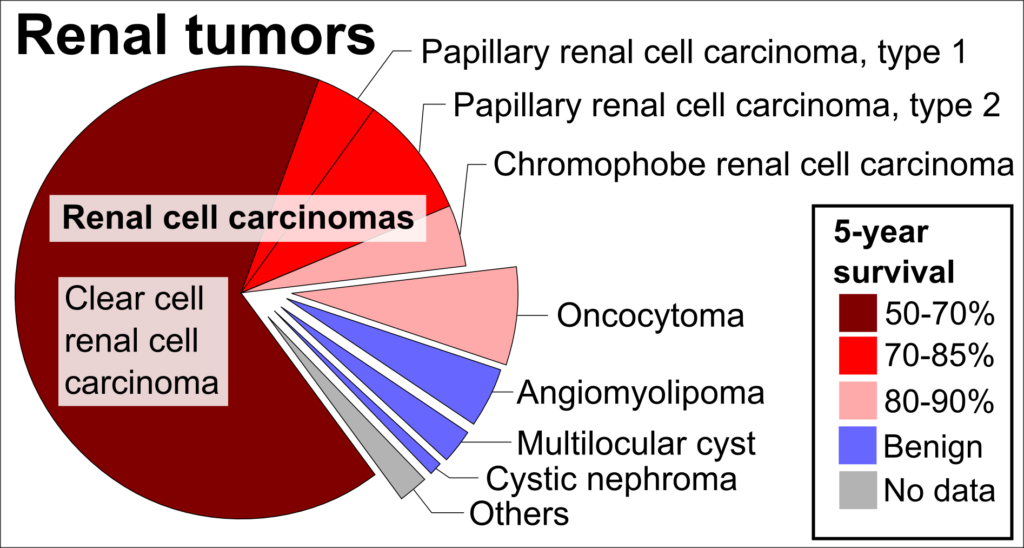Renal cell carcinoma is not the only type of kidney cancer, although it does account for 9 out of 10 cases. About 5% of kidney cancer patients have transitional cell or urothelial carcinoma, which start at the point where the ureters meet the kidneys, the lining of the renal pelvis. As the names of the disease indicate, the malignant cells of this cancer look like bladder cancer or other urothelial carcinomas. Wilms tumor is a type of kidney cancer that occurs in very young children. Renal sarcomas start in the blood vessels or the kidney’s connective tissue and account for approximately 1% of kidney cancers.

Click to Enlarge: Histopathologic types of kidney tumor, with relative incidences and prognoses, including renal cell carcinoma and its subtypes Source: Wikipedia
Renal cell carcinoma itself is divided into more than a dozen types, the most common of which are:
- Clear cell: About 75% of RCC cases are categorized as clear cell, characterized by cells that appear clear or very pale when seen under a microscope. Clear cell is often aggressive, though the degree depends on stage, grade and sarcomatoid transformation;
- Non-clear cell: The remaining 25% are non-clear cell RCC:
- Papillary RCC accounts for 10% to 15% of RCC cases. This tumor type is characterized by small, fingerlike projections. Like clear cell RCC, its aggressiveness varies with its stage, grade and sarcomatoid transformation.
- Clear cell papillary, a relatively new type, has features of both clear cell and papillary and accounts for up to 4% of all RCC cases. It is typically a less aggressive cancer.
- Chromophobe RCC makes up a further 5% of RCC cases. It features large cells with obvious cell borders and a pink or clear tint. It has a low mortality rate.
- Collecting duct RCC is an aggressive cancer that arises in the urine collecting system and resembles irregular tubules. It comprises 1% of RCC cases.
- Eosinophilic cystic-solid RCC is an emerging subtype characterized by voluminous eosinophilic cytoplasm with mixed solid and cystic features. It tends to be indolent.1
- Medullary RCC is another aggressive form that occurs primarily in African Americans who have sickle trait. It accounts for less than 1% of cases.
- Rare RCCs include Xp11 translocation, mucinous tubular and spindle cell, and a form associated with neuroblastoma together comprise less than 1% of cases. These are typically indolent cancers.
- Unclassified RCCs makes up the balance. These have a high mortality rate.
- Yi M, Wang S, Wang P, Wang Z, Lu J, Liu Y. Eosinophilic solid and cystic renal cell carcinoma: a review of literature focused on radiological findings and differential diagnosis. Abdom Radiol (NY). 2023 Jan;48(1):350-357.

